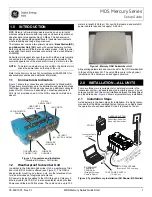
ALTERNATE MICROPHONES AND INSTALLATION
Thus when a voice is used in place of a whistle or tone, in the proper listening mode
the voice will be received correctly whereas in the incorrect mode, the voice will be
translated backwards and cannot be made intelligible by the COARSE/FINE control.
When listening to an AM transmission, a correct side band is heard in either mode since
both upper and lower side bands are received.
For best results, the user should select a low-impedance dynamic type microphone or
a transistorized microphone. Transistorized type microphones have low output
impedance characteristics. The microphones must be provided with a four-lead cable.
The audio conductor and its shielded lead comprise two of the leads. The third lead is
for transmit control and fourth is for receiving control.
Once the desired SSB mode has been selected, frequency adjustment may be
necessary in order to make the incoming signal intelligible. The COARSE/FINE control
allows the operator to vary frequency above or below the exact frequency of the
channel. If the sound of the incoming signal is high or low pitched, adjust the operation
of the COARSE/FINE.
The microphone should provide the functions shown in the schematic below.
4 WIRE MIC CABLE
Consider it as performing the same function as a phonograph speed control. When the
speed is set too high, voices will be high-pitched and if set too low, voice will be low-
pitched. Also, there is only one correct speed that will make a particular record produce
the same sound that was recorded. If the record is played on a turntable that is rotated in
the wrong direction (opposite side band) no amount of speed control (COARSE/FINE)
will produce an intelligible sound.
Pin Number
Mic Cable Lead
1
Audio
Shield
2
Audio Lead
3
Transmit
Control
4
Receive
Control
An AM signal received while listening in one of the SSB modes will produce a steady
tone (carrier) in addition to the intelligence, unless the SSB receiver is tuned to exactly
the same frequency by the COARSE/FINE control. For simplicity, it is recommended
that the AM modes be used to listen to AM signals.
Fig. 1
Your transceiver microphone schematic.
If the microphone to be used is provided with pre-cut leads, they must be revised as
follows.
1. Cut leads so that they extend 7/16" beyond the plastic insulating jacket of the
microphone cable.
2. All leads should be cut to the same length. Strip the ends of each wire 1/8" and tin
the exposed wire.
12
13




























